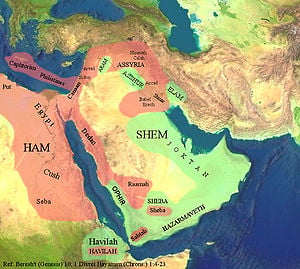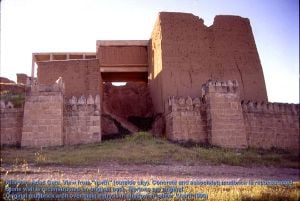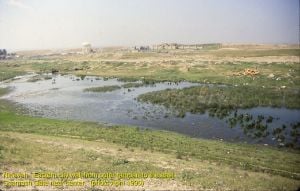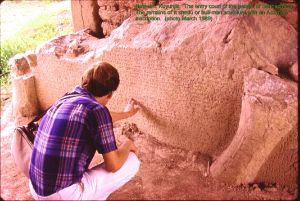Nineveh
Coordinates:
- For other uses, see Nineveh (disambiguation).
| Ancient Mesopotamia |
|---|
| Euphrates – Tigris |
| Assyriology |
| Cities / Empires |
| Sumer: Uruk – Ur – Eridu |
| Kish – Lagash – Nippur |
| Akkadian Empire: Akkad |
| Babylon – Isin – Susa |
| Assyria: Assur – Nineveh |
| Dur-Sharrukin – Nimrud |
| Babylonia – Chaldea |
| Elam – Amorites |
| Hurrians – Mitanni |
| Kassites – Urartu |
| Chronology |
| Kings of Sumer |
| Kings of Assyria |
| Kings of Babylon |
| Language |
| Cuneiform script |
| Sumerian – Akkadian |
| Elamite – Hurrian |
| Mythology |
| Enûma Elish |
| Gilgamesh – Marduk |
| Mesopotamian mythology |
Nineveh (Akkadian: Ninua; Aramaic: ܢܝܢܘܐ; Hebrew: נינוה, Nīnewē; Arabic: نينوى, Naīnuwa), an "exceeding great city," as it is called in the Book of Jonah, lay on the eastern bank of the Tigris in ancient Assyria, across the river from the modern-day major city of Mosul, Iraq.
Geography
Ancient Nineveh's mound-ruins (36°22'N 43°09'E), Kouyunjik and Nabī Yūnus are located on a level part of the plain near the junction of the Tigris and the Khosr Rivers within an 1800-acre (730 ha) area circumscribed by a 12 km (7.5 mile) brick rampart. This whole extensive space is now one immense area of ruins overlaid in parts by new suburbs of the city of Mosul.
Nineveh was an important junction for commercial routes crossing the Tigris. Occupying a central position on the great highway between the Mediterranean Sea and the Indian Ocean, thus uniting the East and the West, wealth flowed into it from many sources, so that it became one of the greatest of all the region's ancient cities.[1]
History
Texts from the Hellenistic period and later offered an eponymous Ninus as the founder of Nineveh. The historic Nineveh is mentioned about 1800 B.C.E. as a centre of worship of Ishtar, whose cult was responsible for the city's early importance. The goddess' statue was sent to Pharaoh Amenhotep III of Egypt in the 14th century B.C.E., by orders of the king of Mitanni. The city of Nineveh was one of Mitanni's vassals until the mid 14th century B.C.E., when the Assyrian kings of Assur seized it.[2]
There is no large body of evidence to show that Assyrian monarchs built at all extensively in Nineveh during the 2nd millennium B.C.E. Later monarchs whose inscriptions have appeared on the high city include Shalmaneser I and Tiglath-Pileser I, both of whom were active builders in Assur; the former had founded Calah (Nimrud). Nineveh had to wait for the neo-Assyrian kings, particularly from the time of Ashurnasirpal II (ruled 883-859 B.C.E.) onward, for a considerable architectural expansion. Thereafter successive monarchs kept in repair and founded new palaces, temples to Sîn, Nergal, Šamaš, Ishtar, and Nabiu of Borsippa.
It was Sennacherib who made Nineveh a truly magnificent city (c. 700 B.C.E.). He laid out new streets and squares and built within it the famous "palace without a rival," the plan of which has been mostly recovered and has overall dimensions of about 503 by 242 meters (1680 by 810 ft). It comprised at least 80 rooms, many of which were lined with sculpture. A large number of cuneiform tablets were found in the palace. The solid foundatiion was made out of limestone blocks and mud bricks; it was 22 meters tall. This is a total of about 2.68 million cubic meters (about 160 million bricks). The walls on top, made out of mud brick, were an additional 20 meters tall. Some of the principal doorways were flanked by colossal stone door figures weighing up to 30 tons; they included many winged lions or bulls with a mans head. These were transported 30 miles from quarries at Balatai and they had to be lifted up 65 feet once they arrived at the site presumably by a ramp. There are also 9880 feet of stone panels carved in bas-relief, that include pictorial records every step including carving the statues and transporting them on a barge. one picture show 44 men towing a colossal statue. The carving shows 3 men directing the operation while standing on the Colossus. Once the statues arrived at there final destination the final carving was done. Most of the statue weigh between 10 and 30 tons. [3] [4]
The stone carvings in the walls include many battle scenes, impalings and scenes showing Sennacherib's men parading the spoils of war before him. He also bragged about his conquests: he wrote of Babylon "Its inhabitants, young and old, I did not spare, and with their corpses I filled the streets of the city." He later wrote about a battle in Lachish "And Hezekiah of Judah who had not submitted to my yoke...him I shut up in Jeruselum his royal city like a caged bird. Earthworks I threw up against him, and anyone coming out of his city gate I made pay for his crime. His cities which I had plundered I had cut off from his land." [5]
At this time the total area of Nineveh comprised about 1,800 acres (7 km²), and fifteen great gates penetrated its walls. An elaborate system of eighteen canals brought water from the hills to Nineveh, and several sections of a magnificently constructed aqueduct erected by Sennacherib were discovered at Jerwan, about 40 km (25 miles) distant. The enclosed area had more than 100,000 inhabitants (maybe closer to 150,000), about twice as many as Babylon at the time, placing it among the largest settlements worldwide.[6]
Nineveh's greatness was short-lived. Around 633 B.C.E. the Assyrian empire began to show signs of weakness, and Nineveh was attacked by the Medes, who about 625 B.C.E., joined by the Babylonians and Susianians, again attacked it. Nineveh fell in 612 B.C.E., and was razed to the ground. The people in the city who could not escape to the last Assyrian strongholds in the west, were either massacred or deported. Many unburied skeletons were found by the archaeologists at the site. The Assyrian empire then came to an end, the Medes and Babylonians dividing its provinces between them.
Following the defeat in 612 B.C.E., the site remained unoccupied for centuries until the Sassanian period. The city is mentioned again in the Battle of Nineveh in 627 C.E., which was fought between the Eastern Roman Empire and the Sassanian Empire of Persia near the ancient city. From the Arab conquest 637 C.E. until modern time the city of Mosul on the opposite bank of the river Tigris became the successor of ancient Nineveh.
Biblical Nineveh

In the Bible, Nineveh is first mentioned in Genesis 10:11: "Ashur left that land, and built Nineveh." Some modern translations interpret "Ashur" in the Hebrew of this verse as the country "Assyria" rather than a person, thus making Nimrod the builder of Nineveh.
Though the Books of Kings and Books of Chronicles talk a great deal about the Assyrian empire, Nineveh itself is not again noticed till the days of Jonah, when it is described (Jonah 3:3ff; 4:11) as an "exceeding great city of three days' journey," i.e., probably in circuit. This would give a circumference of about 100 km (60 miles). It is also possible that it took three days to cover all its neighborhoods by walking, which would match the size of ancient Nineveh. At the four corners of an irregular quadrangle are the ruins of Kouyunjik, Nimrud, Karamles and Khorsabad. These four great masses of ruins, with the whole area included within the parallelogram they form by lines drawn from the one to the other, are generally regarded as composing the whole ruins of Nineveh. It was also mentioned in Jonah that Nineveh was an evil city that needed to be condemned. To fix this problem, God sent Jonah to preach to Nineveh, and they repented.
Nineveh was the flourishing capital of the Assyrian empire (2 Kings 19:36; Isa. 37:37). The book of the prophet Nahum is almost exclusively taken up with prophetic denunciations against this city. Its ruin and utter desolation are foretold (Nahum 1:14; 3:19, etc.). Its end was strange, sudden, tragic. (Nahum 2:6–11) According to the Bible, it was God's doing, his judgement on Assyria's pride (Jonah Nah). In fulfilment of prophecy, God made "an utter end of the place." It became a "desolation." Zephaniah also (2:13–15) predicts its destruction along with the fall of the empire of which it was the capital.
Nineveh's repentence and salvation from evil is noted in the Gospel of Matthew (12:41) and the Gospel of Luke (11:32).
Nineveh in classical history
Before the excavations in the 1800s, historical knowledge of the great Assyrian empire and of its magnificent capital was almost wholly a blank. Other cities that had perished, such as Palmyra, Persepolis, and Thebes, had left ruins to mark their sites and tell of their former greatness; but of this city, imperial Nineveh, not a single vestige seemed to remain, and the very place on which it had stood became only matter of conjecture.
In the days of the Greek historian Herodotus, 400 B.C.E., Nineveh had become a thing of the past; and when Xenophon the historian passed the place in the Retreat of the Ten Thousand the very memory of its name had been lost. It was buried out of sight.

Archaeology
Today, Nineveh's location is marked by two large mounds, Kouyunjik and Nabī Yūnus "Prophet Jonah," and the remains of the city walls (about 12 km/7.5 mi in circumference). The Neo-Assyrian levels of Kouyunjik have been extensively explored. The other mound, Nabī Yūnus, has not been extensively explored because there is a Muslim shrine dedicated to that prophet on the site. However, Iraqi excavations on Nabī Yūnus in 1990 exposed a number of large Neo-Assyrian sculptures that appeared to be the entrance to a palace.
In the 19th century, the French consul at Mosul began to search the vast mounds that lay along the opposite bank of the river. The Arabs whom he employed in these excavations, to their great surprise, came upon the ruins of a building at the mound of Khorsabad, which, on further exploration, turned out to be the royal palace of Sargon II, which was largely explored for sculptures and other precious relics.
In 1847 the young British adventurer Sir Austen Henry Layard explored the ruins. In the Kuyunjik mound Layard rediscovered in 1849 the lost palace of Sennacherib with its 71 rooms and colossal bas-reliefs. He also unearthed the palace and famous library of Ashurbanipal with 22,000 cuneiform clay tablets. The study of the archaeology of Nineveh reveals the wealth and glory of ancient Assyria under kings such as Esarhaddon (681-669 B.C.E.) and Ashurbanipal (669-626 B.C.E.).
The work of exploration was carried on by George Smith, Hormuzd Rassam, and others, and a vast treasury of specimens of Assyria was incrementally exhumed for European museums. Palace after palace was discovered, with their decorations and their sculptured slabs, revealing the life and manners of this ancient people, their arts of war and peace, the forms of their religion, the style of their architecture, and the magnificence of their monarchs.
The mound of Kuyunjik were excavated again by the archaeologists of the British Museum, lead by Leonard William King, at the beginning of the twentieth century. Their efforts concentrated on the site of the Temple of Nabu, the god of writing, where another cuneiform library was supposed to exist. However, no such library was ever found: most likely, it had been destroyed by the activities of later residents.
The excavations started again in 1927, under the direction of Campbell Thompson, who had already taken part in King's expeditions. These excavations, however, were rather unfortunate. Some works were carried out outside Kouyunjik, for instance on the mound of Nebi Yunus, which was the ancient arsenal of Nineveh, or along the outside walls. Here, near the northwestern corner of the walls, beyond the pavement of a later building, the archaeologists found almost 300 fragments of prisms recording the royal annals of Sennacherib, Esarhaddon and Ashurbanipal, beside a prism of Esarhaddon which was almost perfect.
After the Second World War, several excavations were carried out by Iraqi archaeologists. Nineveh was revisited by British archaeologist and Assyriologist Professor David Stronach of the University of California, Berkeley. (1981 to present). He conducted a series of surveys and digs at the site from 1987-1990, focusing his attentions to the several gates and the existent mud brick walls, as well as the system that supplied water to the city in times of siege.
City wall and gates
The ruins of Nineveh are surrounded by the remains of a massive stone and mudbrick wall dating from about 700 B.C.E. About 12 km. in length, the wall system consisted of an ashlar stone retaining wall about 6 m. high surmounted by a mudbrick wall about 10 m. high and 15 m. thick. The stone retaining wall had projecting stone towers spaced about every 18 m. The stone wall and towers were topped by three-step merlons.
The city wall was fitted with fifteen monumental gateways. In addition to serving as check points on entering and exiting the city, these structures were probably used as barracks and armories. With the inner and outer doors closed, the gateways were virtual fortresses. The bases of the walls of the vaulted passages and interior chambers of the gateway were lined with finely cut stone orthostats about 1 m. high. A stairway led from one of the interior chambers to the top of the mudbrick wall.
Five of the gateways have been explored to some extent by archaeologists:
Mashki Gate. Translated "Gate of the Watering Places," it was perhaps used to take livestock to water from the River Tigris which currently flows about 1.5 km. to the west. It has been reconstructed in fortified mudbrick to the height of the top of the vaulted passageway and seems accurate as far as it goes. The Assyrian original may have been plastered and ornamented.
Nergal Gate. Named for the god Nergal, it may have been used for some ceremonial purpose, as it is the only known gate flanked by stone sculptures of winged bull-men (lamassu). The reconstruction is conjectural, as the gate was excavated by Layard in the mid 19th century, and reconstructed in the mid 20th century.
Adad Gate. Named for the god Adad. A reconstruction was begun in the 1960s by Iraqis, but was not completed. The result is an uneasy mixture of concrete and eroding mudbrick, which nonetheless does give one some idea of the original structure. Fortunately, the excavator left some features unexcavated, allowing a view of the original Assyrian construction. The original brickwork of the outer vaulted passageway is well exposed, as is the entrance of the vaulted stairway to the upper levels. The actions of Nineveh's last defenders can be seen in the hastily built mudbrick construction which narrows the passageway from 4 m. to 2 m.
Shamash Gate. Named for the Sun god Shamash, it opens to the road to Arbil. It was excavated by Layard in the 19th century. The stone retaining wall and part of the mudbrick structure were reconstructed in the 1960s. The mudbrick reconstruction has deteriorated significantly. The stone wall projects outward about 20 m. from the line of main wall for a length of about 70 m. It is the only gate with such a significant projection. The mound of its remains towers above the surrounding terrain. Its size and design suggest it was the most important gate in Neo-Assyrian times.
Halzi Gate. Near the south end of the eastern city wall. Exploratory excavations were undertaken here by the University of California expedition of 1989-90. There is an outward projection of the city wall, though not as pronounced as at the Shamash Gate. The entry passage had been narrowed with mudbrick to about 2 m. as at the Adad Gate. Human remains from the final battle of Nineveh were found in the passageway.
Kuyunjik
The ruin mound of Kuyunjik rises about 20 m above the surrounding plain of the ancient city. It is quite large, measuring about 800 m x 500 m. Its upper layers have been extensively excavated and several Neo-Assyrian palaces and temples have been found there. A deep sounding by Max Mallowan revealed evidence of habitation as early as the 6th millennium B.C.E.
Today, there is little evidence of these old excavations other than weathered pits and earth piles. In 1990, the only Assyrian remains visible were those of the entry court and the first few chambers of the Palace of Sennacherib. Since that time, the palace chambers have received significant damage by looters due to the turmoil in the area. Portions of relief sculptures that were in the palace chambers in 1990 were seen on the antiquities market by 1996. Photographs of the chambers made in 2003 show that many of the fine relief sculptures there have been reduced to piles of rubble. (see link to Joanne Farchakh-Bajjaly photos)
A small area of undisturbed post-Assyrian remains was identified in 1990 near the southwest corner of Kuyunjik.
Nebi Yunus
Nebi Yunus, located about 1 km. south of Kuyunjik, is the secondary ruin mound at Nineveh. On the basis of texts of Sennacherib, the site has traditionally been identified as the "armory" of Nineveh, and a gate and pavements excavated by Iraqis in 1954 have been considered to be part of the "armory" complex. Excavations in 1990 revealed a monumental entryway consisting of a number of large inscribed orthostats and "bull-man" sculptures, some apparently unfinished.
Rogation of the Ninevites (Nineveh's Wish)
Assyrians of the Syriac Orthodox Church, Chaldean Catholic Church and Assyrian Church of the East practice a fast called Ba'uta d-Ninwe or Bo'utho d-Ninwe (ܒܥܘܬܐ ܕܢܝܢܘܐ) which means Nineveh's Wish. Copts and Ethiopian Orthodox also maintain this fast. See article about the Roagation of the Ninevites
Modern Nineveh
On 15 October 2005, the province of Nineveh (Ninawa) cast the deciding votes in the referendum for Iraq's Constitution. One of three mostly Sunni Arab provinces whose veto could defeat the constitution, Nineveh was closely watched through the extended electoral count.
Home to a majority Sunni Arab population and ethnically diverse minority which includes Kurds (Yezidi and Sunni) and Assyrian Christians, as well as the oil processing center Mosul (which is often considered to be the modern Nineveh city, and is called so by Aramaic speakers), the province of Nineveh promises to play a large role in Iraqi politics into the future.
Notes
- ↑ "Proud Nineveh" is a constant emblem of earthly pride in the Old Testament prophecies: "And He will stretch out His hand against the north And destroy Assyria, And He will make Nineveh a desolation, Parched like the wilderness." (Zephaniah 2:13).
- ↑ Genesis 10:11 attributes the founding of Nineveh to an Asshur: "Out of that land went forth Asshur, and builded Nineveh".
- ↑ "The Seventy Wonders of the Ancient World" edited by Chris scarre 1999 (Thames and Hudson)
- ↑ An experiment in the 1950s required 180 men to tow a ten-ton colossus on Easter Island.
- ↑ Time Life Lost Civilizations series: Mesopotamia: The Mighty Kings. (1995)
- ↑ See also Historical urban community sizes.
ReferencesISBN links support NWE through referral fees
- This entry incorporates text from the public domain Easton's Bible Dictionary, originally published in 1897.
External links
- Joanne Farchakh-Bajjaly photos of Nineveh taken in May 2003 showing damage from looters.
- John Malcolm Russell, "Stolen stones: the modern sack of Nineveh" in Archaeology; looting of sculptures in the 1990s.
- Nineveh page at the British Museum's website. Includes photographs of items from their collection.
- ABC 3: Babylonian Chronicle Concerning the Fall of Nineveh
- Layard's Nineveh and its Remains- full text
- A history
- Austen Henry Layard - Nineveh and Its Remains full book readable
Credits
New World Encyclopedia writers and editors rewrote and completed the Wikipedia article in accordance with New World Encyclopedia standards. This article abides by terms of the Creative Commons CC-by-sa 3.0 License (CC-by-sa), which may be used and disseminated with proper attribution. Credit is due under the terms of this license that can reference both the New World Encyclopedia contributors and the selfless volunteer contributors of the Wikimedia Foundation. To cite this article click here for a list of acceptable citing formats.The history of earlier contributions by wikipedians is accessible to researchers here:
The history of this article since it was imported to New World Encyclopedia:
Note: Some restrictions may apply to use of individual images which are separately licensed.








